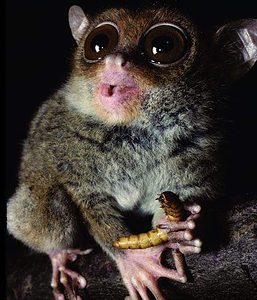
The size of a fist when fully grown, the tiny Philippine tarsier has always been considered a very quiet being. Ironically, this big eyed, lemur-like animal wasn’t quiet at all, you just needed the right ears to hear him our. Recently, researchers at Humboldt State University in California have proven that the Philippine tarsier is quite the chatty being, communicating with its peers in high-pitch sounds, similar to a bat, which can not be picked up by humans or most of its predators. This makes it the world’s highest pitched primate vocalization ever documented.
Found only on some remote islands in the Philippines, although the Philippine tarsiers are one of the smallest primate species, they have a “big mouth” to make up for it. They’re nocturnal beings, and hide very well, coupled with the fact that they’re endagered and don’t respond well at all to captivity, made them very tricky test subjects. Marissa Ramsier, an evolutionary biologist who was part of the study, and her colleagues had to move fast and smart, if their tests were to become relevant.
Six tarsiers were captured and inserted each in a sound-muffling chamber. There, the tiny primates were exposed to ultrasounds of varying frequencies, while noninvasive electrodes were attached to their heads such that brain activity could be recorded. If there was any brain activity recorded as a response to a certain sound frequency, it means that the tarsier could hear it. The procedure is very similar to the one used to test newborn babies if they have the full range of hearing. The researchers found that the tarsiers could hear pitches as high as 91 kilohertz, far higher than the galago (bush baby), whose 65 kHz limit was the highest recorded among a primate thus far.
If they can hear these high-pitch sounds, then surely they can communicate in ultrasounds as well? Using a bat-detector (ultrasound microphone), scientists recorded the the calls of 35 wild tarsiers, and found that eight of the animals cried out in pure ultrasound, ranging from 67 to 79 kHz, with the most common frequency coming in around 70.
“This is the first time that a primate has been shown to use vocalization that is only in the ultrasound, so this call doesn’t use anything in the lower frequencies that we can hear,” Ramsier said.
Other primates have been found to fully or partly cry out in ultrasounds, however the tarsiers are well beyond anything recorded thus far. The scientists working on the study believe they eventually evolved this trait as a means of stealth communication, so that the tarsiers could secretly “discuss” between one another without lurking predators tapping in. A lot of insects communicate in high pitch sounds as well, so this trait might be a great hunting tool as well.
“It’s this duel benefit,” she said. “They can communicate without predators hearing them and also locate some potential food sources.”
There are lot of things happening in the world, you just need to listen and see with the right ears and eyes.





